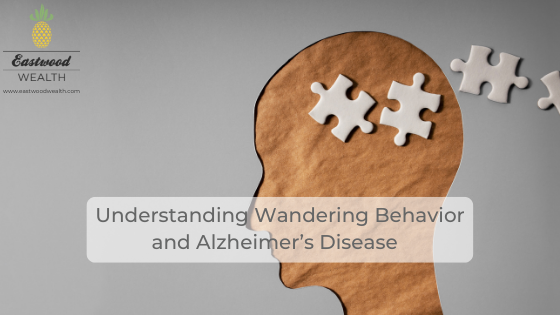June 3, 2022

The inability to recognize familiar people and places is a hallmark of Alzheimer’s disease and related forms of dementia. As the disease progresses, severe cognitive impairment can further reduce an individual’s participation in activities of daily living (ADLs), including grooming, eating, driving, speaking, and reasoning. Typically, short-term memory loss is the most noticeable symptom of Alzheimer’s, but in many cases, an individual’s long-term memory is somewhat retained. Many individuals with Alzheimer’s who wander do so frequently with a purpose rooted in their past—going to a job or looking for a beloved relative, friend, or spouse. Wandering may also be caused from restlessness, stress, a change in environment, time disorientation, or even side effects from medication.
According to the Alzheimer’s Association, six in 10 people with Alzheimer’s will wander off from home or an extended care facility during some stage of the disease, forget their names or addresses, and get lost. This behavior is often repeated once it begins, and can be dangerous and potentially life-threatening. In recent years, incidents have been reported nationwide in which an individual with Alzheimer’s either was seriously injured or died tragically as a result of wandering.
Reducing the Risks
Most people with Alzheimer’s are at risk for wandering. However, there are ways that caregivers and staff members of long term care facilities can help prevent wandering by identifying the risk factors for this behavior and recognizing the signals before an incident happens. Here are some prevention guidelines to help reduce the risk of wandering:
Redirect Restlessness. Some form of daily exercise or movement can often reduce symptoms of agitation or restless pacing behavior. To redirect can be as simple as refocusing an individual in an activity like folding laundry, drying dishes, or meal preparation. Depending on the health of the individual and stage of the disease, many people can engage in walking or other recreational activities with the companionship of a caregiver or care facility staff member.
Position Mirrors near Doorways. An individual may get discouraged from leaving the premises if his or her reflection appears in a mirror placed next to an exit. Note that this may not work in the advanced stage of the disease.
Attend to Basic Needs. Regular meal times and nutritious snacks, plenty of fluids, and regular toileting habits will help to reduce discomfort, fear, or anxiety.
Communicate with an Upbeat Attitude. Although people with Alzheimer’s are cognitively impaired, many are still able to perceive the difference between harsh or impatient tones and reassuring, positive voices, and tend to react accordingly.
Minimize Effects of Sundowning. The sundowning syndrome, which includes mood swings, hallucinations, and paranoia, may affect individuals with Alzheimer’s disease and other dementias when daylight ends. For people with Alzheimer’s, sundowning often triggers wandering behavior. Therefore, it is important to discourage afternoon napping, limit caffeine and sugar intake to daytime only, serve dinner early with a light snack before bedtime, plan daytime activities with plenty of daylight exposure, and place night lights throughout the home or facility.
Enroll in Safety Programs. The Alzheimer’s Association in partnership with police departments across the country has introduced a 24-hour emergency response service that issues an identification bracelet for people who wander or have a medical emergency. For more information on specific programs, visit www.alz.org.
Take the Keys Away. One of the most difficult challenges facing caregivers is recognizing when a person with Alzheimer’s should stop driving. However, since cars can quickly become an easy channel for wandering, endangering not only the driver’s life but the lives of others, the conversation needs to take place before an incident occurs.
Install Security Locks. Slide-bolt locks at the top or bottom of doors can be installed out of the general line of sight to prevent wandering. In addition, warning bells can be placed above doors. However, a person with Alzheimer’s must never be locked inside and left alone.
Although 60% of people with Alzheimer’s and dementia disorders will wander, there are ways to help prevent that first occurrence. It may not always be easy for caregivers and care providers to remain vigilant at all times when challenged with danger-prone behaviors. But, by taking these suggested precautions and contacting the Alzheimer’s Association for assistance, it may be possible to recognize the triggers and help save lives.
Important Disclosures
Content in this material is for educational and general information only and not intended to provide specific advice or recommendations for any individual.
All information is believed to be from reliable sources; however LPL Financial makes no representation as to its completeness or accuracy.
This article was prepared by Liberty Publishing, Inc.
Tracking # 1-05289554
VIEW OUR Business Continuity Plan
CFP® Certified Financial Planner™ Certified Financial Planner Board of Standards, Inc. owns the certification marks above, which it awards to individuals who successfully complete initial and ongoing certification requirements.
Securities and advisory services offered through LPL Financial, a Registered Investment Advisor Member FINRA + SIPC.
The LPL Financial registered representative associated with this site may only discuss and/or transact securities business with residents of the Following states: NC, VA, SC, MD, DE and FL.
Financial planning services offered through LPL Financial, a registered investment advisor